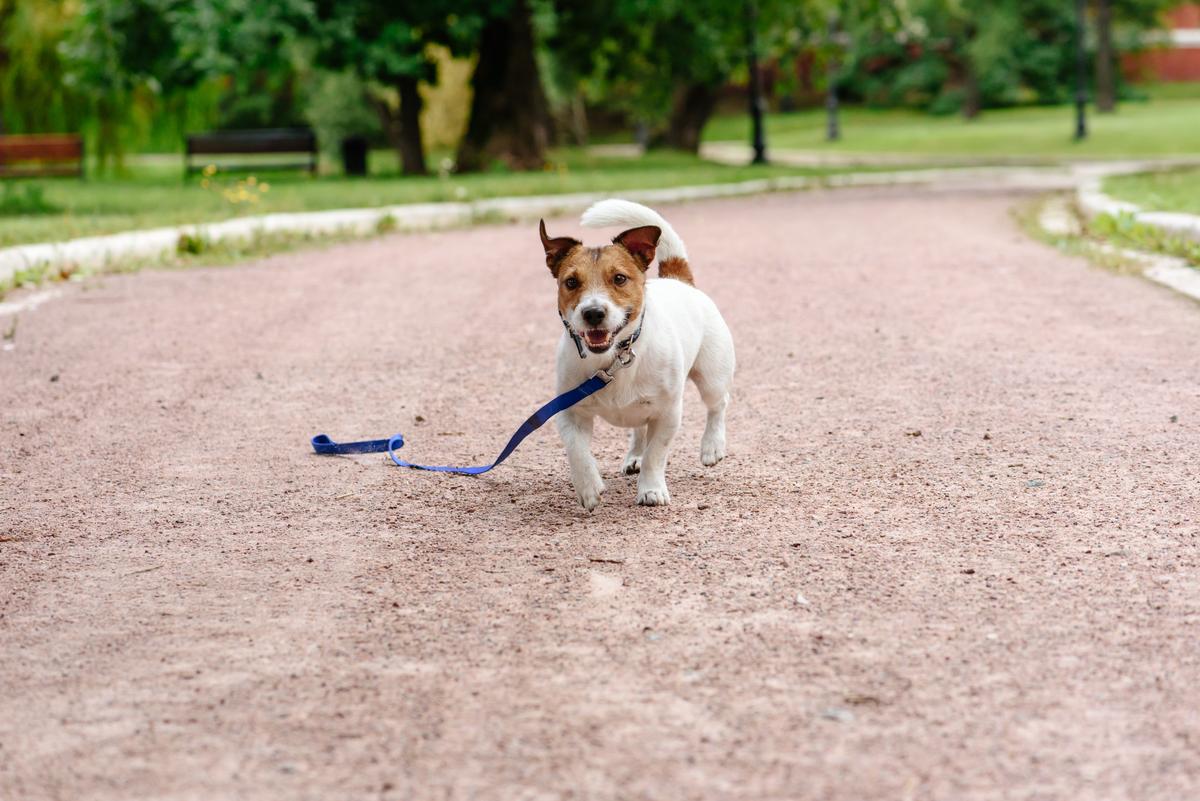It's an unfortunate situation no pet owner wants to face - the sudden realization that your dog is missing. The stress and fear multiply when it occurs at night, reducing visibility and making the search more challenging. But fret not, because this guide is here to help. We will walk you through the effective strategies of finding a lost dog at night, ensuring that you have the tools and techniques needed to locate your beloved pet.

Nighttime Pet Search: The Challenge
Night can cloak everything in obscurity, making it difficult to distinguish between a lost pet and the myriad shadows lurking around your neighbourhood. The challenge lies not only in reduced visibility but also in the increased activity of nocturnal wildlife that might lead your dog astray or distract you during your search.
Lost Dog Search Tips
Let's start by exploring some essential tips for searching for your lost dog at night.
Start Immediately: The first step in finding a lost dog, regardless of the time, is to start immediately. The more time you lose, the farther your dog can stray.
Use a Strong Flashlight: A powerful flashlight is a crucial tool in nighttime pet searches. It can help you see further and may catch the reflective surfaces of a dog's eyes or collar.
Attract with Familiar Smells: Dogs have an exceptional sense of smell. Use this to your advantage by placing items carrying your scent or your dog's favourite toys in your garden or near your house.
Listen Carefully: In the quiet of the night, a distant bark or rustling might lead you to your missing pet. Keep your ears as open as your eyes.
Nighttime Pet Search Strategies
A systematic approach can make your search efficient and effective. Let's delve into some strategies you can implement when looking for your lost dog at night.
Start from the Last Known Location: This is often the most effective starting point. From there, you can gradually extend your search radius.
Form Search Teams: Involving friends, family, or neighbours can help cover more ground faster. Make sure each team has a flashlight and a cell phone.
Use Social Media: Posting about your missing pet on local social media groups can increase the number of eyes on the lookout for your dog.
Leave Your Door Open: If your dog finds its way back while you are out searching, an open door can be a welcoming sign.
Effective Dog Search Methods
After getting a good grasp on the search strategies, it's time to introduce some specific methods to make your search even more effective.
Use Your Dog's Favourite Sound: Dogs have exceptional hearing. Using their favourite sounds like the squeak of their favourite toy or the sound of food being poured into their bowl can draw them out of their hiding place.
Creating a Scent Path: You could create a scent path back to your home by dragging a piece of clothing that has your scent around your neighbourhood. As we mentioned earlier, dogs have an extraordinary sense of smell, and your scent could encourage your dog to follow the trail back home.
Use a Drone: If you have access to a drone, especially one with a camera, use it. This method can give you a bird's eye view of the area and possibly spot your dog from above.
Check Likely Hiding Spots: Dogs who are scared might seek out small, dark places to hide. Look under cars, behind bushes, and in other potential hiding spots.

Enlisting Professional Help
Sometimes, despite your best efforts, you might need to call in the professionals. That's okay. There are lost pet agencies and pet detectives who specialize in these situations and have additional resources and techniques that can help.
Pet Amber Alert: Similar to Amber Alerts for missing children, there are services to help alert your community quickly when your pet goes missing. They send out automated phone calls, fliers, and social media posts within minutes.
Pet Detective: These professionals use scent tracking dogs to locate your lost pet. They can be a bit pricey, but their services could be invaluable when it comes to finding your pet quickly.
Microchip Companies: If your dog is microchipped, contact the company to report your dog missing. Many companies will send out alerts to local vets and shelters for you.
Enlisting Professional Help
No matter how dedicated and diligent you are, there may come a point when it's time to call in the professionals. These experts can bring in additional resources, experiences, and methods to aid your search.
Contact Local Animal Shelters and Vets: Your first call should be to local animal shelters and veterinary clinics. Provide them with a detailed description and recent photo of your pet. Even better, visit them in person if possible - your visit will underscore the urgency of the situation.
Reach Out to Animal Control Agencies: Animal control agencies can be of significant help. They're often the ones who deal with stray animals and might have already found your dog.
Hire a Pet Detective: Yes, they exist, and they can be incredibly useful! Pet detectives are professionals trained in tracking and locating lost pets. They use various techniques, from behavioral profiling to thermal imaging and surveillance cameras, to find your lost dog.
Use a Pet Recovery Service: Companies like Pet Amber Alert operate much like Amber Alerts for missing children. They send out alerts about your lost pet to a vast network of vets, animal shelters, and pet owners in your area.
Tech Can Be Your Best Friend
In this digital age, technology can offer some fantastic tools to help locate your lost pet.
Online Platforms: Websites like Nextdoor, Pawboost, and PetFBI allow you to post about your lost pet. These posts can reach a large number of people in your local area, increasing the chances of someone spotting your dog.
Use Social Media: Don't underestimate the power of social media. A single post can reach thousands of people, especially if it's shared widely within local groups.
Mobile Apps: There are several pet recovery apps available that can assist you in your search. They work by alerting local app users about your lost pet, increasing the eyes on the lookout.

Expanding the Search
If your immediate local area search doesn't yield results, it might be time to expand the search for your lost dog. Dogs can wander off quite far, especially if they're scared or chasing after something.
Engage Local Community: Extend your efforts to the wider community. Inform your mail carrier, local delivery people, and other regular passers-by in your area about your lost dog. These people know your area well and can be invaluable in your search.
Broaden Your Online Outreach: If you've already posted on local social media groups, consider expanding to county or city-level groups. Include clear photos and a description of your dog, along with your contact information in all posts.
Use Mass Media: Consider placing a lost dog ad in your local newspaper or radio station. This can extend the reach of your search significantly, especially to those who may not use social media.
The Waiting Game
There will come a time when you've done all you can, and the next step is to wait and hope for good news.
Stay Vigilant: Keep your phone with you at all times and answer all calls, even from unknown numbers. It could be someone with information about your dog.
Keep Checking In: Regularly check in with your local shelters, vets, and animal control agencies. Despite the initial reporting, your dog might be brought in at a later time.
Don’t Lose Hope: It's important to stay positive during this challenging time. There are many stories of lost pets being found days, weeks, and even months after they went missing.
The Best Prevention: Fi Dog Collars
Prevention, as they say, is the best cure. As a pet owner, one of your primary goals should be to prevent your pet from getting lost in the first place. This is where Fi comes into play.
Fi dog collars are not just any dog collar. They are the best collars for dogs, equipped with cutting-edge GPS technology that allows you to keep an eye on your dog's location in real-time. If your dog manages to wander off, you won't have to wait till nightfall or comb through every street. The GPS tracker in Fi dog collars will give you their precise location, anytime and anywhere.
Even better, Fi collars come with a feature that allows you to set up a geofenced area for your pet. If your dog steps out of this defined area, you'll receive instant notifications on your phone. This way, you can act immediately even before your dog gets too far.
In conclusion, finding a lost dog at night can be daunting, but with the right strategies, effective methods, professional help, and preventive measures like Fi collars, the process can be made significantly easier. Remember, the key is to stay calm and act promptly. Your dog is depending on you.
The Power of Microchipping and Fi Dog Collars
Prevention is always better than cure. Two of the most effective preventive measures are microchipping your pet and using GPS-enabled collars like those offered by Fi.
Microchipping: A microchip is a tiny device inserted under your dog's skin. It carries a unique number that can be read by a scanner. If your lost dog is found and taken to a vet or shelter, one of the first things they'll do is check for a microchip.
Fi Dog Collars: If you're looking for the best collar for dogs, look no further than Fi. These advanced collars come with built-in GPS technology that lets you monitor your dog's location in real-time, right from your smartphone. If your dog goes missing, you'll know exactly where to look.
But the features of Fi dog collars go beyond just location tracking. They also provide insights into your dog's daily activity levels, ensuring they are getting enough exercise. Plus, they are durable, waterproof, and have a battery that lasts for weeks, making them the perfect accessory for your adventurous pet.
In conclusion, finding a lost dog at night can be stressful, but it's not impossible. Use the strategies, methods, and resources shared in this guide, and the odds will be in your favour. With a bit of effort, luck, and a Fi dog collar, you'll have your furry friend back in no time.

In Conclusion: Maximizing Your Efforts to Safely Find Your Lost Dog at Night
Losing your beloved pet can be a heartbreaking experience, amplified by the darkness of night that might seem like an additional adversary. However, with the strategies, methods, and resources outlined in this comprehensive guide, you're well-equipped to face this challenge head-on.
Act immediately and use practical strategies like forming search teams, using familiar smells and sounds, and leaving your door open. Your dog might be closer than you think, possibly hiding in fear or waiting for a familiar sign to return home. Utilize flashlights and listen to your surroundings, as your dog might respond to your calls.
Consider adopting unconventional but effective methods such as scent paths, drones, or leveraging your dog's favourite sounds. Every dog is unique, and understanding your dog's behaviour can significantly improve your search efforts.
Don't hesitate to call in professional help when needed. Services like local shelters, animal control, pet detectives, and pet recovery services can provide invaluable assistance. Use technology to your advantage - online platforms, social media, and mobile apps can help spread the word and garner community support in locating your lost pet.
Broaden your search if your immediate efforts don't yield results. Stay vigilant and maintain regular communication with local authorities, vets, and shelters. It's also essential to keep your spirits high during this challenging time. Stay hopeful and persistent; countless lost dogs have been successfully reunited with their owners even after a significant amount of time.
In hindsight, preventive measures such as microchipping and GPS tracking collars can prove to be a game-changer in such situations. They allow swift location tracking, reducing the time your pet spends lost and the stress you experience during the ordeal.
In closing, while losing a dog can be stressful and finding them at night can be challenging, it is not an impossible task. This guide is your go-to resource in such times. Remember, your dog is relying on you. Your swift actions, determination, and the effective use of available resources significantly enhance the chances of being reunited with your furry friend. With a well-laid plan and by keeping hope alive, you are always just one step away from embracing your lost companion again.

